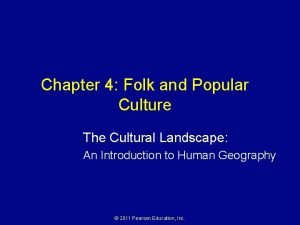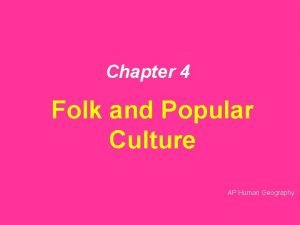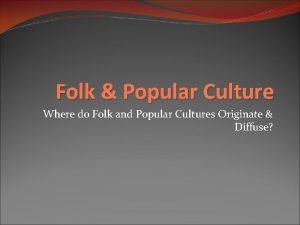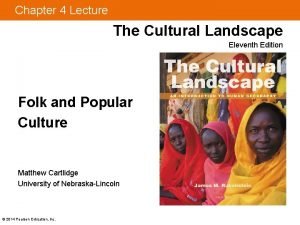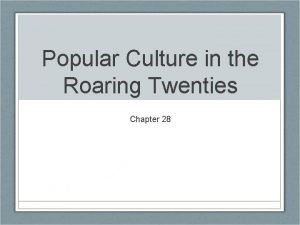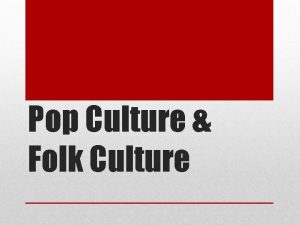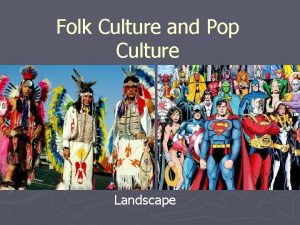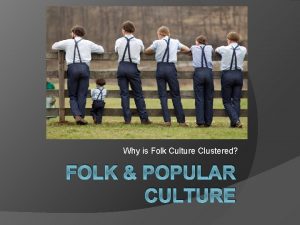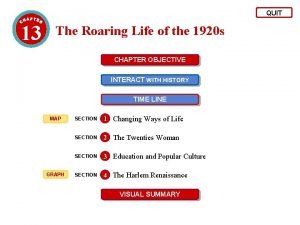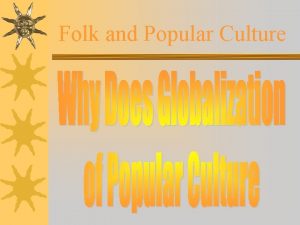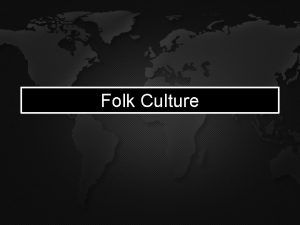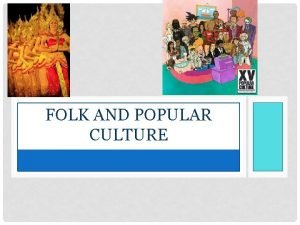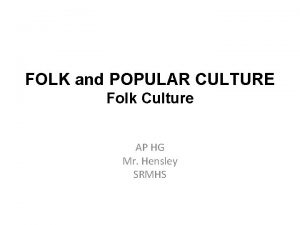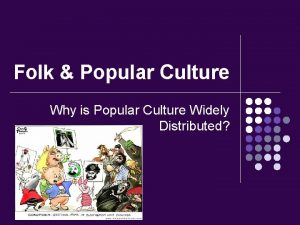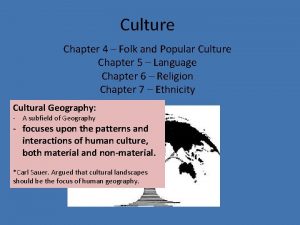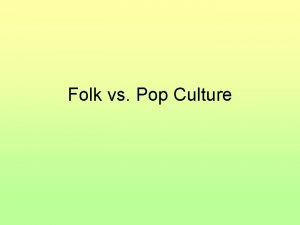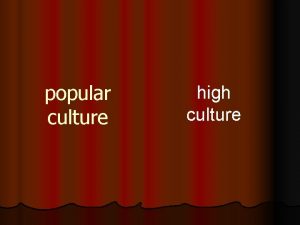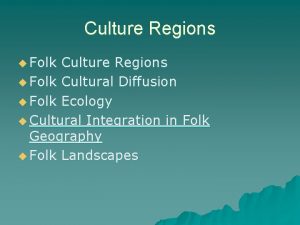Chapter 4 Folk Popular Culture Copyright 2012 John





























- Slides: 29

Chapter 4: Folk & Popular Culture Copyright © 2012 John Wiley & Sons, Inc. All rights reserved.

Key Question What are local and popular cultures? © 2012 John Wiley & Sons, Inc. All rights reserved.

What Are Local & Popular Cultures? • A culture is the body of material traits, customary beliefs, and social forms that together constitute the distinct tradition of a group of people. • A group of people who share common beliefs can be recognized as a culture in one of two ways: 1. The people call themselves a culture. 2. Other people (including academics) can label a certain group of people as a culture. © 2012 John Wiley & Sons, Inc. All rights reserved.

How Does a Culture Influence a Behavior? • A habit is a repetitive act that a particular individual performs, such as wearing jeans to class every day. • A custom is a repetitive act of a group, performed to the extent that it becomes characteristic of the group – such as many students typically wearing jeans to class © 2012 John Wiley & Sons, Inc. All rights reserved.

How Does a Culture Influence a Behavior? • A custom is therefore a habit that has been widely adopted by a group of people habit does not imply that the act has been adopted. • In this chapter custom may be used to denote a specific element of material culture such as wearing jeans, whereas culture refers to a group’s ENTIRE collection of customs © 2012 John Wiley & Sons, Inc. All rights reserved.

Introducing Folk and Popular Culture – Two Types of Culture • Folk culture is traditionally practiced primarily by small, homogeneous groups living in (typically) isolated rural areas (Strong family ties and strong interpersonal relationships). • Popular culture is large, incorporates heterogeneous societies that share certain habits despite differences in other personal characteristics. © 2012 John Wiley & Sons, Inc. All rights reserved.

Introducing Folk and Popular Culture – Two Types of Culture • Landscapes dominate by folk culture change relatively little over time. • It is more likely to vary from place to place at a given time. • Poplar culture is based on rapid simultaneous global connections through communication systems. • Fueled by mass media and consumerism – including visual and performing arts. © 2012 John Wiley & Sons, Inc. All rights reserved.

Introducing Folk and Popular Culture – Two Types of Culture • Global scale – popular culture is becoming more dominant and is threatening the survival of unique folk culture and the environment. • Folk culture is derived from local natural elements whereas popular culture is more likely to modify the environment. • Pop culture does not reflect the local environment; it looks the same anywhere it appears. © 2012 John Wiley & Sons, Inc. All rights reserved.

Origin, Diffusion, and Distribution of Folk and Popular Culture • Each cultural element has a unique spatial distribution – in general, distribution is more extensive for popular culture than for folk culture. • Two ways to explain the different spatial distribution of popular and folk cultures: • The process of origin • Pattern of diffusion © 2012 John Wiley & Sons, Inc. All rights reserved.

Origin – Folk Culture • Often Folk culture will have anonymous hearths (unknown dates, locations, originators) • Artifacts include music, food, entertainment, fashion, recreation and various forms of art © 2012 John Wiley & Sons, Inc. All rights reserved.

Origin – Popular Culture • Popular culture is typically traceable to a specific person or place and conveyed by terms such as “fad” or “trend”. • Example – Hip Hop – is considered to have originated on August 11, 1973 NY. • First Rap Song – Blondie – “Rapture” © 2012 John Wiley & Sons, Inc. All rights reserved.

Origin – Popular Culture • Pop music and culture like food and clothing arise from combination of technology and increased leisure time. • Industrial technology permits the uniform reproduction of objects in large quantities (i. Phones, T -shirts, pizzas at Little Caesars) © 2012 John Wiley & Sons, Inc. All rights reserved.

Diffusion – Folk Culture • Folk culture is transmitted from one location to another relatively slowly and on a small scale. • Primarily through relocation diffusion migration. © 2012 John Wiley & Sons, Inc. All rights reserved.

Diffusion – Popular Culture • Diffuses rapidly and extensively from hearths or nodes of innovation with the help of modern communication • Typically spreading through the process of hierarchical diffusion. • Hearth - Point of origin • Examples include techno music, Hip Hop, Metal © 2012 John Wiley & Sons, Inc. All rights reserved.

Motley Crue Loudness © 2012 John Wiley & Sons, Inc. All rights reserved.

Distribution – Popular Culture • Popular culture is distributed widely across many countries, With little regard for physical factors. • Distribution is influenced by the ability of people to access the material. • The principal obstacle is the lack of income © 2012 John Wiley & Sons, Inc. All rights reserved.

Distribution – Folk Culture • Combination of local, physical and cultural factors influence distinctive distributions. • The principal obstacle is distance and mountain ranges. © 2012 John Wiley & Sons, Inc. All rights reserved.

Distribution – Folk Culture (Religion) • Despite proximity in the Himalaya Mountains of Bhutan, Nepal, northern India and southern Tibet contains four religious groups: • Tibetan Buddhists in the north • Hindus in the south • Muslims in the west • Southeast Asian folk religionists in the east © 2012 John Wiley & Sons, Inc. All rights reserved.

Geographical Differences Between Folk and Popular Culture • The region covered by a folk culture is typically much smaller than that covered by a popular culture. • The reason: connections or lack of it. © 2012 John Wiley & Sons, Inc. All rights reserved.

Origin and Diffusion of Folk Music • According to Chinese legend, music was invented in 2697 B. C. • In reality, folk songs originate anonymously and are transmitted orally • Content is often derived from events in daily life – life-cycles (birth, death and marriage) or environmental features (agricultural climate). • Migration of people also diffuses the music. © 2012 John Wiley & Sons, Inc. All rights reserved.

Origin and Diffusion of Popular Music • Originated in 1900, invented with the intent of being sold or performed in front of a paying audience. • Written to provide musical entertainment for music halls and vaudeville. • The music industry was in New York and went worldwide in 1940 s and the Armed Forces Radio Network. © 2012 John Wiley & Sons, Inc. All rights reserved.

Origin and Diffusion of Popular Music • New York, Los Angeles and San Francisco – examples of cities with cultural activities that appeal to a wide variety of artists and cluster musicians. © 2012 John Wiley & Sons, Inc. All rights reserved.

Folk Culture: Origin of Soccer • Worlds most popular sport – known as football by the rest of the world – originates as a folk custom in England in 11 th century. • As with other folk customs, soccer’s origin is obscure. © 2012 John Wiley & Sons, Inc. All rights reserved.

Popular Culture: Diffusion of Soccer • Becomes popular culture in 1800 s as a way to provide factory workers with recreation. • Increasing leisure time permitted people not only to play but also view them. © 2012 John Wiley & Sons, Inc. All rights reserved.

Olympic and Folk Sports • To be in the Summer Olympics a sport must be widely played in 75 countries (50 for women) and on four continents – Sports that do not meet this criteria – American football and baseball. • Most sports are diffused less than soccer. © 2012 John Wiley & Sons, Inc. All rights reserved.

Cricket • Popular in U. K. and on former British Colonies – South Asia (India), South Pacific and Caribbean Islands © 2012 John Wiley & Sons, Inc. All rights reserved.

Ice Hockey and Wushu • Ice Hockey prevails in colder climates – Russia and Northern Europe • Wushu is China’s most popular sport – Martial Arts © 2012 John Wiley & Sons, Inc. All rights reserved.

Australian Rules Football • Distinctive form of football developed in Australia – Rugby is a different take on the same idea © 2012 John Wiley & Sons, Inc. All rights reserved.

Lacrosse • Played by the Iroquois, Europeans colonists in Canada would pick it up and diffuse it United States North East. © 2012 John Wiley & Sons, Inc. All rights reserved.
 Folk culture and popular culture venn diagram
Folk culture and popular culture venn diagram Folk cultures are spread primarily by
Folk cultures are spread primarily by Folk culture and popular culture venn diagram
Folk culture and popular culture venn diagram Chapter 4 folk and popular culture
Chapter 4 folk and popular culture Folk culture origins
Folk culture origins Folk and popular culture
Folk and popular culture Hearth example ap human geography
Hearth example ap human geography How do the origins of folk and popular culture differ?
How do the origins of folk and popular culture differ? Examples of folk and popular culture
Examples of folk and popular culture Why is access to folk and popular culture unequal
Why is access to folk and popular culture unequal Folk songs ap human geography
Folk songs ap human geography Chapter 28 popular culture in the roaring twenties
Chapter 28 popular culture in the roaring twenties Chapter 13 section 3 education and popular culture
Chapter 13 section 3 education and popular culture Education and popular culture lesson 5 answer key
Education and popular culture lesson 5 answer key Chapter 19 section 1 postwar america
Chapter 19 section 1 postwar america Dentist copyright 2012
Dentist copyright 2012 Copyright 2012
Copyright 2012 Clean leader
Clean leader Copyright 2012
Copyright 2012 Whats pop culture
Whats pop culture Threats to folk culture
Threats to folk culture Where does the 100 take place
Where does the 100 take place Folk culture sports
Folk culture sports Folk examples
Folk examples Folk culture definition
Folk culture definition Why is folk culture clustered?
Why is folk culture clustered? Why do ldcs fear the loss of folk culture
Why do ldcs fear the loss of folk culture Amish folk culture
Amish folk culture 1920 popular culture
1920 popular culture Notes on deconstructing the popular summary
Notes on deconstructing the popular summary



